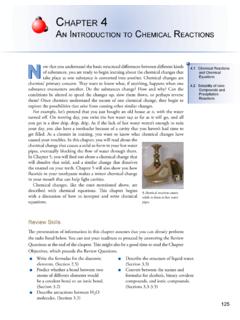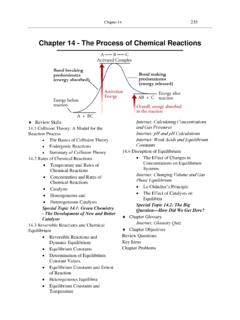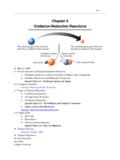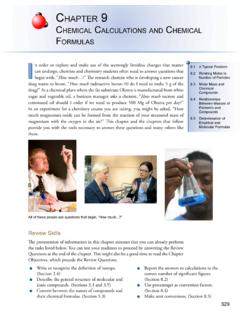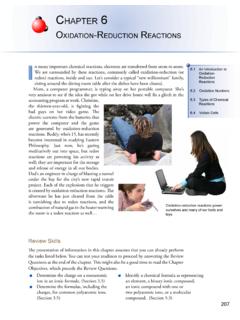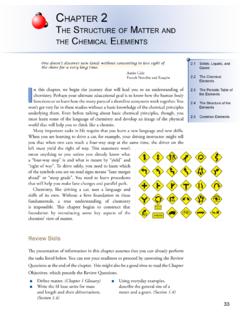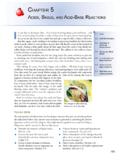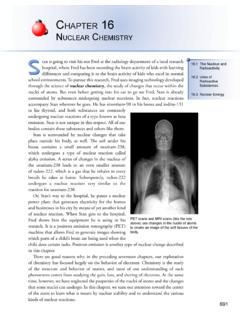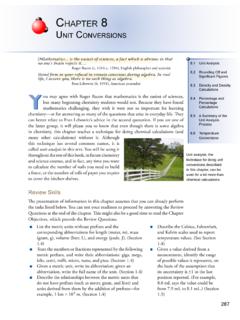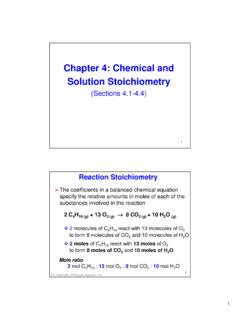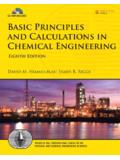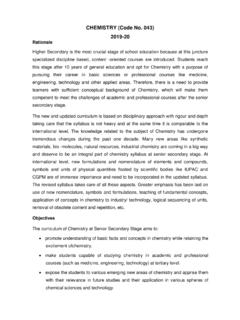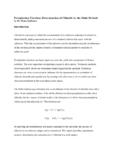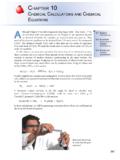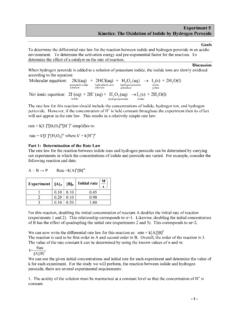Transcription of Chapter 10 ChemiCal alCulations and equations
1 Chapter 10 ChemiCal CalCulations and ChemiCal equations367lthough Chapter 9 was full of questions that began with, How we are not done with such questions yet. In Chapter 9, our questions focused on ChemiCal formulas. For example, we answered such questions as, How much of the element vanadium can be obtained from metric tons of the compound V2O5? The ChemiCal formula V2O5 told us that there are two moles of vanadium, V, in each mole of V2O5. We used this molar ratio to convert from moles of V2O5 to moles of vanadium.
2 In this Chapter , we encounter questions that focus instead on ChemiCal reactions. These questions ask us to convert from amount of one substance in a given ChemiCal reaction to amount of another substance participating in the same reaction. For example, a business manager, budgeting for the production of silicon based computer chips, wants to know how much silicon can be produced from 16 kg of carbon and 32 kg of silica, SiO2, in the reaction SiO2(s) + 2C(s) Si(l) + 2CO(g)2000 CA safety engineer in a uranium processing plant, wants to know how much water needs to be added to 25 pounds of uranium hexafluoride to maximize the synthesis of UO2F2 by the reaction UF6 + 2H2O UO2F2 + 4 HFA chemistry student working in the lab might be asked to calculate how much 1 bromo 2 methylpropane, C4H9Br, could be made from g of 2 methyl 2 propanol, C4H9OH, in the reaction 3C4H9OH + PBr3 3C4H9Br + H3PO3In these calculations.
3 We will be generating conversion factors from the coefficients in the balanced ChemiCal equation. Equation Real-World Applications of Equation Molarity and Equation StoichiometryHow much product can be made from the given reactants? Equation StoichiometryChapter 9 asked you to pretend to be an industrial chemist at a company that makes phosphoric acid, H3PO4. The three step furnace method for producing this compound is summarized by these three equations : 2Ca3(PO4)2 + 6 SiO2 + 10C 4P + 10CO + 6 CaSiO34P(s) + 5O2(g) P4O10(s)P4O10(s) + 6H2O(l) 4H3PO4(aq)Following the strategy demonstrated in Example , we calculated the maximum mass of tetraphosphorus decoxide, P4O10, that can be made from 104 kilograms of phosphorus in the second of these three reactions.
4 The answer is 104 kg P4O10. We used the following steps: Balance ChemiCal equations . (Section ) Write or identify the definitions of solution, solute, and solvent. (Section ) Given a description of a solution, identify the solute and solvent. (Section ) Describe water solutions in terms of the nature of the particles in solution and the attractions between them. (Sections and ) Given formulas for two ionic compounds, predict whether a precipitate will form when water solutions of the two are mixed, and write the complete equation that describes the reaction.
5 (Section ) Convert between names of ChemiCal substances and their ChemiCal formulas. (Section ) Given the names or formulas for a monoprotic or polyprotic acid and an ionic compound containing hydroxide, carbonate, or hydrogen carbonate ions, write the complete balanced equation for the neutralization reaction that takes place between them. (See Section ) Make general unit conversions. (Sections and ) Report answers to calculations using the correct number of significant figures. (Section ) Find the atomic mass for elements, the molecular mass for molecular compounds, and the formula mass for ionic compounds.
6 (See Sections and ) Use the atomic mass for elements, the molecular mass for molecular compounds, and the formula mass for ionic compounds to convert between mass and moles of substance. (Sections and )Review SkillsThe presentation of information in this Chapter assumes that you can already perform the tasks listed below. You can test your readiness to proceed by answering the Review Questions at the end of the Chapter . This might also be a good time to read the Chapter Objectives, which precede the Review 104 kg Pkg P4O10 g P mol P mol P4O10 g P4O10?
7 Kg P4O10 = 104 kg P1 mol g P1 mol P4O104 mol g P4O101 mol P4O101 kg103 g= 104 kg P4O101 kg103 g368 Chapter 10 ChemiCal Calculations and ChemiCal Equation stoichiometry 369 The ratio of moles of P4O10 to moles of P (which came from the subscripts in the ChemiCal formula, P4O10) provided the key conversion factor that allowed us to convert from units of phosphorus to units of tetraphosphorus decoxide. Now let s assume that you have been transferred to the division responsible for the final stage of the process, the step in which tetraphosphorus decoxide is converted into phosphoric acid in the third reaction in the list displayed above.
8 Your first assignment there is to calculate the mass of water in kilograms that would be necessary to react with 104 kg P4O10. The steps for this conversion are very similar to those in Example : 104 kg P4O10kg H2O g P4O10 mol P4O10 mol H2O g H2 OAs part of our calculation, we convert from moles of one substance (P4O10) to moles of another (H2O), so we need a conversion factor that relates the numbers of particles of these substances. The coefficients in the balanced ChemiCal equation provide us with information that we can use to build this conversion factor.
9 They tell us that six molecules of H2O are needed to react with one molecule of P4O10 in order to produce four molecules of phosphoric acid: P4O10(s) + 6H2O(l) 4H3PO4(aq)Thus the ratio of amount of H2O to amount of P4O10 is6 molecules H2O1 molecule P4O10We found in Chapter 9 that it is convenient to describe numbers of molecules in terms of moles. If the reaction requires six molecules of water for each molecule of P4O10, it would require six dozen H2O molecules for each dozen P4O10 molecules, or six moles of H2O for each mole of P4O10 (Table ).
10 6 mol H2O1 mol P4O106 dozen H2O1 dozen P4O10orobjeCtive 2 Table Derived from the Coefficients in the Balanced Equation for the Reaction That Produces Phosphoric Acid P4O10(s) + 6H2O(l) 4H3PO4(aq)1 molecule P4O106 molecules H2O4 molecules H3PO41 dozen P4O10 molecules6 dozen H2O molecules4 dozen H3PO4 1023 molecules P4O106( 1023) molecules H2O4( 1023) molecules H3PO41 mole P4O106 moles H2O4 moles H3PO4 Example shows how the coefficients in a balanced ChemiCal equation provide a number of conversion factors that allow us to convert from moles of any reactant or product to moles of any other reactant or - Equation StoichiometryWrite three different conversion factors that relate moles of one reactant or product in the reaction below to moles of another reactant or product in this reaction.
